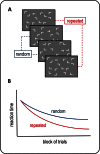Underpowered samples, false negatives, and unconscious learning
- PMID: 26122896
- PMCID: PMC4742512
- DOI: 10.3758/s13423-015-0892-6
Underpowered samples, false negatives, and unconscious learning
Abstract
The scientific community has witnessed growing concern about the high rate of false positives and unreliable results within the psychological literature, but the harmful impact of false negatives has been largely ignored. False negatives are particularly concerning in research areas where demonstrating the absence of an effect is crucial, such as studies of unconscious or implicit processing. Research on implicit processes seeks evidence of above-chance performance on some implicit behavioral measure at the same time as chance-level performance (that is, a null result) on an explicit measure of awareness. A systematic review of 73 studies of contextual cuing, a popular implicit learning paradigm, involving 181 statistical analyses of awareness tests, reveals how underpowered studies can lead to failure to reject a false null hypothesis. Among the studies that reported sufficient information, the meta-analytic effect size across awareness tests was d z = 0.31 (95 % CI 0.24-0.37), showing that participants' learning in these experiments was conscious. The unusually large number of positive results in this literature cannot be explained by selective publication. Instead, our analyses demonstrate that these tests are typically insensitive and underpowered to detect medium to small, but true, effects in awareness tests. These findings challenge a widespread and theoretically important claim about the extent of unconscious human cognition.
Keywords: Contextual cuing; False negatives; Implicit learning; Null hypothesis Significance testing· Statistical power.
Figures







References
-
- *Barnes, K. A., Howard, J. H., Jr., Howard, D. V., Gilotty, L., Kenworthy, L., Gaillard, W. D., & Vaidya, C. J. (2008). Intact implicit learning of spatial context and temporal sequences in childhood autism spectrum disorder. Neuropsychology, 22, 563–570. - PubMed
Publication types
MeSH terms
LinkOut - more resources
Full Text Sources
Other Literature Sources

